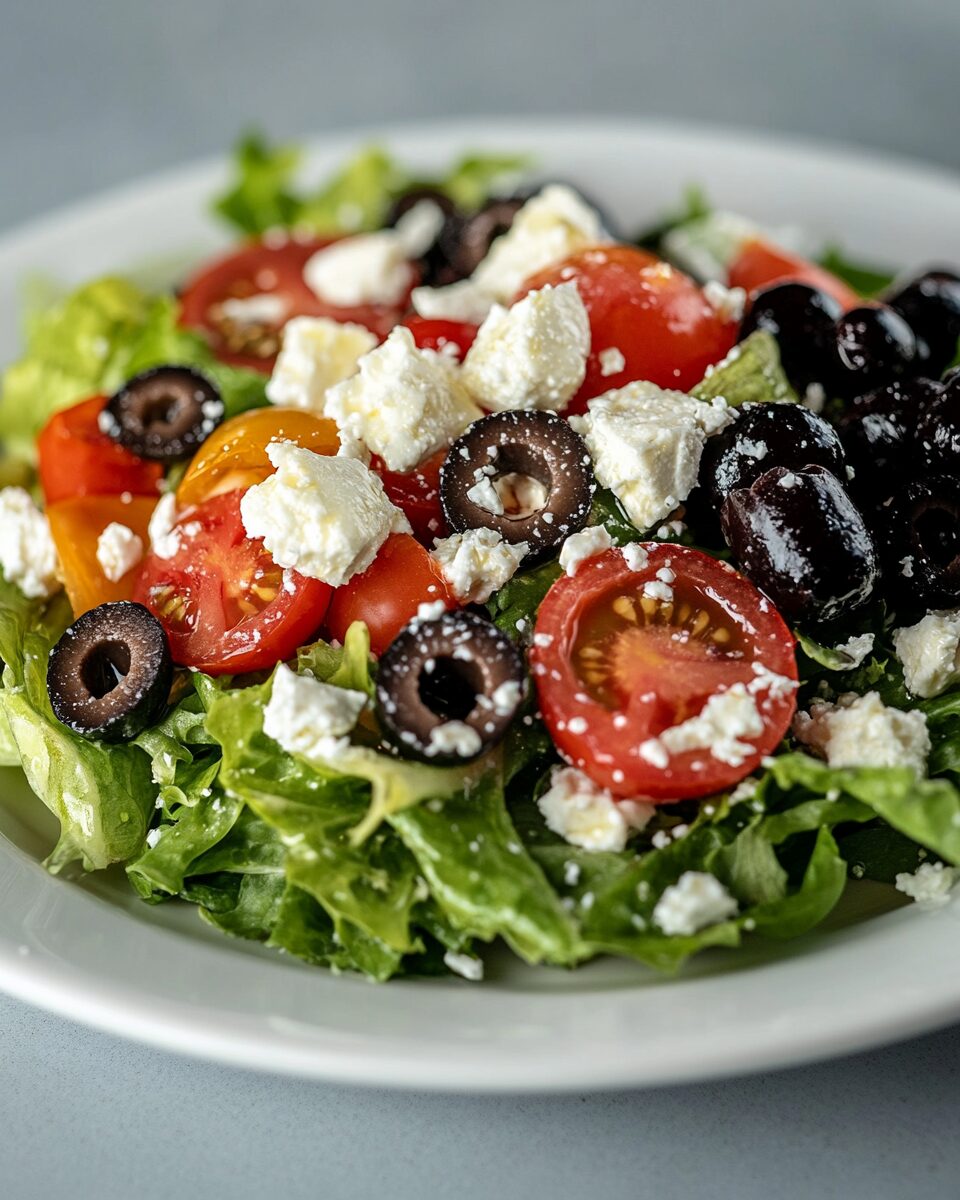This Zesty Greek Salad is a refreshing, vibrant dish bursting with Mediterranean flavors. Perfect as an appetizer or side dish, it combines crisp vegetables, tangy feta cheese, and a zesty dressing. It’s quick to make and pairs wonderfully with grilled meats, fish, or even as a light lunch on its own.
Full Recipe:
Ingredients
For the Salad:
- 4 cups of chopped romaine lettuce
- 1 cup of cherry tomatoes, halved
- 1 cucumber, sliced into half-moons
- 1 red bell pepper, chopped
- 1/2 red onion, thinly sliced
- 1/2 cup Kalamata olives, pitted
- 1/2 cup crumbled feta cheese
For the Dressing:
- 1/4 cup extra virgin olive oil
- 2 tbsp red wine vinegar
- 1 tbsp lemon juice (freshly squeezed)
- 1 tsp dried oregano
- 1/2 tsp Dijon mustard
- 1 garlic clove, minced
- Salt and black pepper, to taste
Directions
- Prepare the Salad: In a large salad bowl, combine romaine lettuce, cherry tomatoes, cucumber, bell pepper, red onion, and Kalamata olives.
- Make the Dressing: In a small bowl or jar, whisk together olive oil, red wine vinegar, lemon juice, oregano, Dijon mustard, and minced garlic. Season with salt and black pepper to taste.
- Toss the Salad: Drizzle the dressing over the salad and toss gently to combine, ensuring the vegetables are evenly coated.
- Add Feta: Sprinkle crumbled feta cheese on top just before serving.
- Serve and Enjoy: Serve immediately for the freshest flavor. This salad is best eaten the same day it’s prepared.
Nutrients (Per Serving)
- Calories: ~180 kcal
- Protein: ~4 g
- Carbohydrates: ~10 g
- Fat: ~14 g
- Fiber: ~3 g
- Sodium: ~350 mg
Origins and Cultural Significance
The Greek salad, or Horiatiki, has its roots in the rural villages of Greece, traditionally prepared by farmers using locally sourced ingredients. The term “Horiatiki” translates to “village” or “peasant” salad, reflecting its humble beginnings. This salad was a staple in the daily diet of Greeks, especially during the hot summer months, providing a refreshing and nutritious meal that required no cooking. The simplicity and accessibility of its ingredients made it a popular choice among the working class.
Interestingly, while the salad is now synonymous with Greek cuisine, the inclusion of tomatoes is a relatively recent development. Tomatoes were introduced to Greece in the early 19th century but didn’t gain widespread popularity until the late 19th and early 20th centuries. Before their introduction, the salad likely consisted of ingredients like cucumbers, olives, and onions, dressed with olive oil and vinegar. The addition of tomatoes added a new dimension to the flavor and texture of the salad, contributing to its modern form.
Nutritional Benefits
The Zesty Greek Salad is not only a feast for the senses but also a powerhouse of nutrients:
- Tomatoes: Rich in vitamins A and C, potassium, and lycopene—a potent antioxidant known for its potential anti-cancer properties.
- Cucumbers: Composed mostly of water, cucumbers are hydrating and low in calories, making them excellent for weight management.
- Red Bell Peppers: High in vitamin C and various antioxidants, they support immune health and reduce inflammation.
- Red Onions: Contain antioxidants and compounds with anti-inflammatory properties, contributing to heart health.
- Kalamata Olives: Provide monounsaturated fats, which are heart-friendly and help in reducing bad cholesterol levels.
- Feta Cheese: A good source of calcium and protein, supporting bone health and muscle function.
- Olive Oil: Rich in monounsaturated fats and antioxidants, it promotes heart health and has anti-inflammatory effects.
The Role of Quality Ingredients
The magic of a Greek salad lies in the quality of its ingredients. Since the recipe relies on minimal preparation, each component must be fresh and of high quality:
- Olive Oil: The cornerstone of the dressing, olive oil must be extra virgin and cold-pressed to provide its signature richness and fruity undertones. Greek olive oil is particularly prized for its robust flavor.
- Feta Cheese: Authentic feta is made from sheep’s milk or a blend of sheep’s and goat’s milk, giving it a tangy and creamy flavor unmatched by cow’s milk alternatives. Choosing a block of feta rather than pre-crumbled varieties ensures a fresher taste.
- Vegetables: The cucumbers, tomatoes, peppers, and onions should be as fresh as possible, preferably in-season and locally sourced. Their natural flavors will shine without needing additional enhancements.
- Kalamata Olives: These olives are a hallmark of Greek cuisine, known for their deep purple hue and rich, fruity flavor. Ensuring they’re pitted and marinated adds an extra layer of flavor.
A Mediterranean Lifestyle on a Plate
The Zesty Greek Salad embodies the principles of the Mediterranean diet, which has been lauded as one of the healthiest in the world. This way of eating emphasizes whole, natural foods, healthy fats, and an abundance of vegetables. Studies have shown that adhering to the Mediterranean diet can reduce the risk of chronic diseases, improve heart health, and promote longevity.
In many ways, enjoying a Greek salad is about more than just the food. It represents a lifestyle that values leisurely meals, fresh ingredients, and the joy of sharing with others. Whether it’s a quiet lunch at home or a shared meal with friends, the salad encourages mindfulness and connection.
Perfect for All Occasions
The adaptability of the Greek salad makes it suitable for any occasion:
- Summer Barbecues: Its refreshing nature and vibrant colors make it an ideal addition to outdoor gatherings, pairing effortlessly with grilled foods.
- Dinner Parties: It can be served as a sophisticated appetizer, setting the tone for a flavorful Mediterranean-inspired menu.
- Light Meals: For a quick, nourishing lunch, simply pair it with a slice of pita bread or some grilled protein.
Tips for a Perfect Salad
Creating the ultimate Zesty Greek Salad requires attention to a few details:
- Chill the Ingredients: Keeping the vegetables chilled ensures the salad is crisp and refreshing.
- Dress Right Before Serving: Tossing the salad in the dressing just before serving keeps the vegetables crunchy and prevents wilting.
- Use Fresh Herbs: While dried oregano is traditional, adding a sprinkle of fresh oregano or parsley can elevate the flavor.
Health Advantages
Incorporating the Zesty Greek Salad into your diet can offer several health benefits:
- Antioxidant Properties: The combination of fresh vegetables provides a rich source of antioxidants, which combat oxidative stress and may reduce the risk of chronic diseases such as heart disease and cancer.
- Heart Health: Ingredients like olive oil and olives contribute to improved cholesterol levels and reduced blood pressure, supporting cardiovascular health.
- Bone Health: Feta cheese offers calcium, essential for maintaining strong bones and preventing osteoporosis.
- Weight Management: The salad is low in calories yet high in fiber, promoting satiety and aiding in weight control.
Culinary Variations
While the traditional Greek salad is simple, regional variations exist:
- Cretan Greek Salad (Dakos): Includes barley rusks and sometimes capers, adding a unique texture and flavor.
- Cypriot Salad: Incorporates ingredients like capers and parsley, reflecting the island’s distinct culinary influences.
These variations showcase the adaptability of the Greek salad to different local ingredients and preferences.
Conclusion
The Zesty Greek Salad is more than just a dish; it’s a reflection of Greek culture and the Mediterranean way of life. Its combination of fresh, wholesome ingredients not only delivers a burst of flavors but also offers numerous health benefits. Whether enjoyed as a side dish or a light meal, this salad embodies the principles of simplicity, nutrition, and culinary delight.






